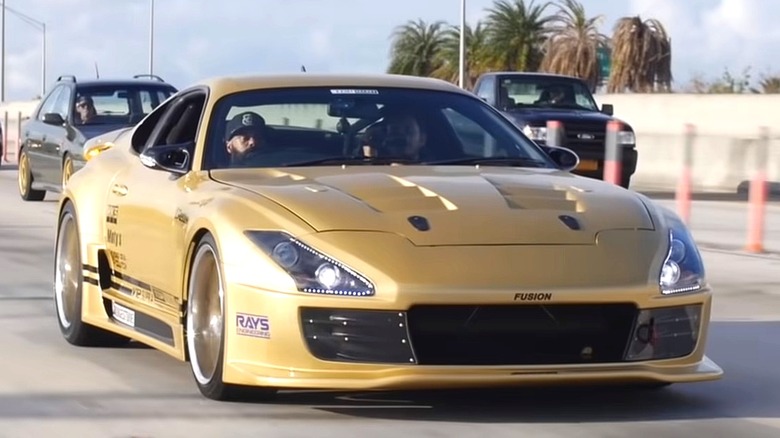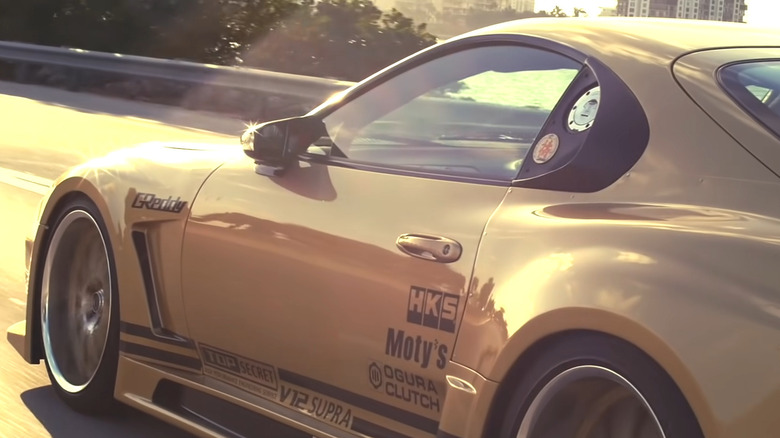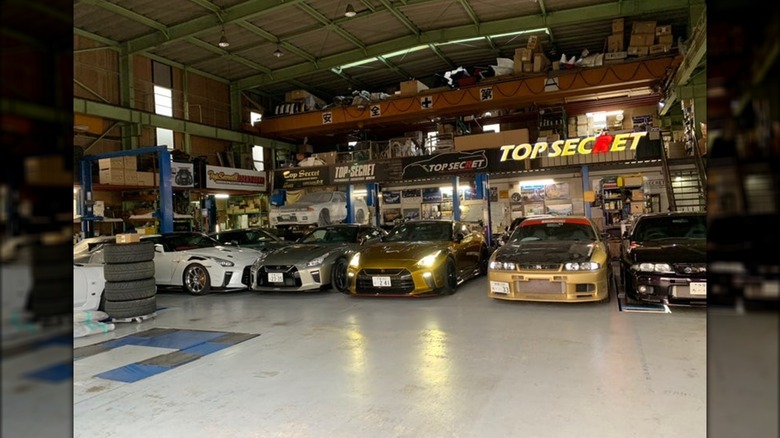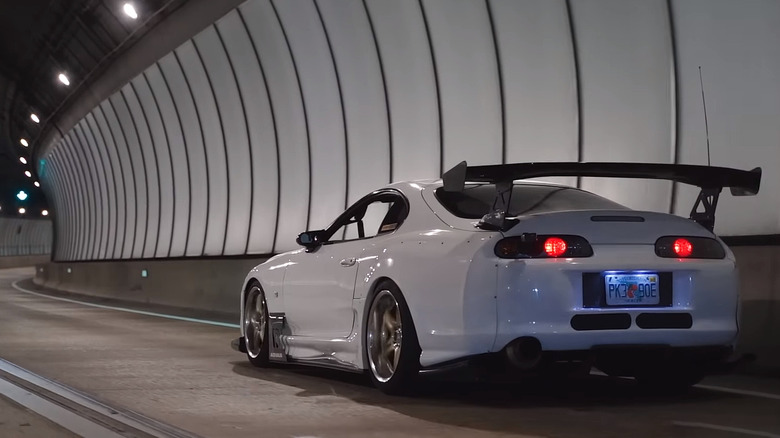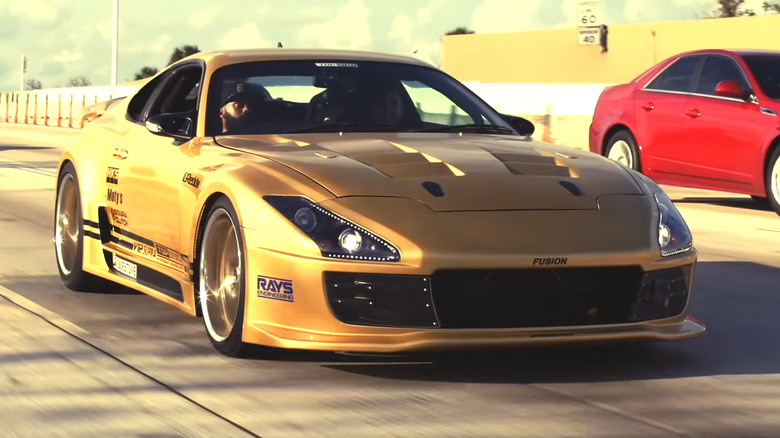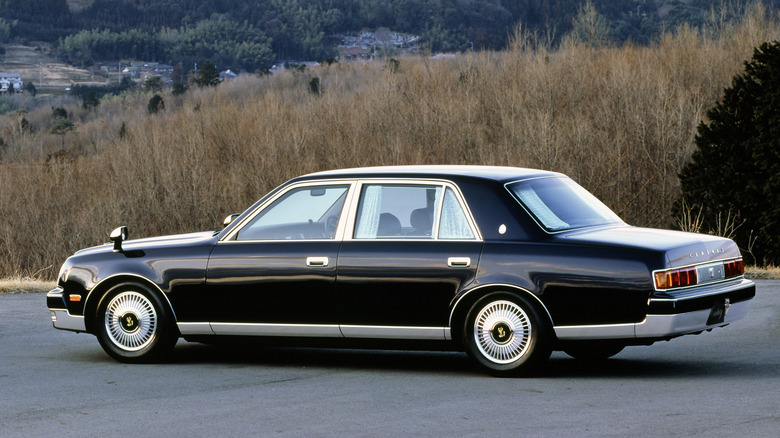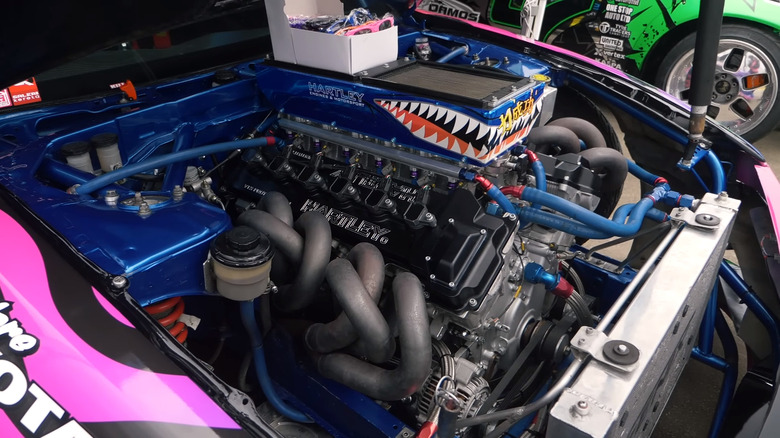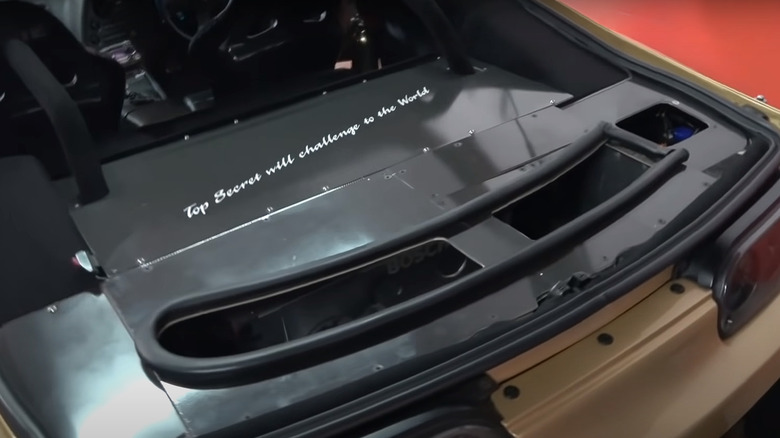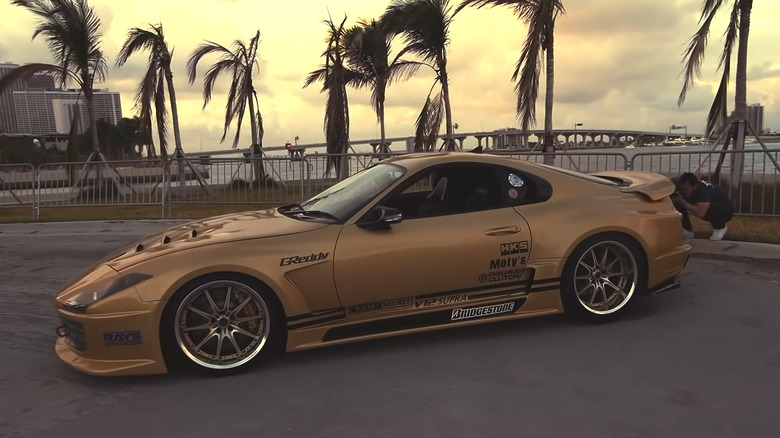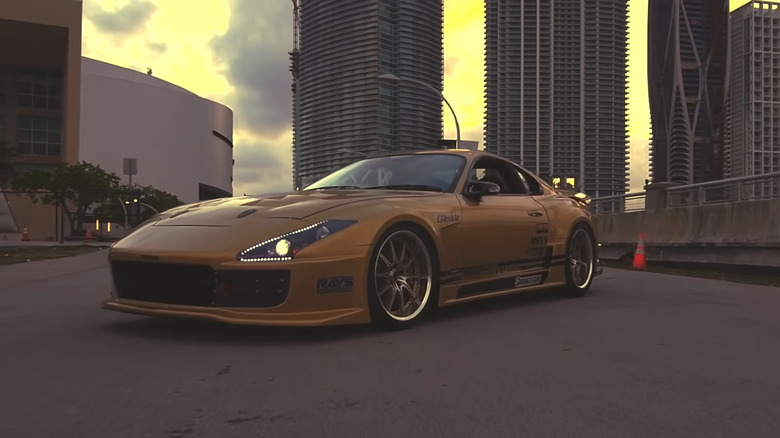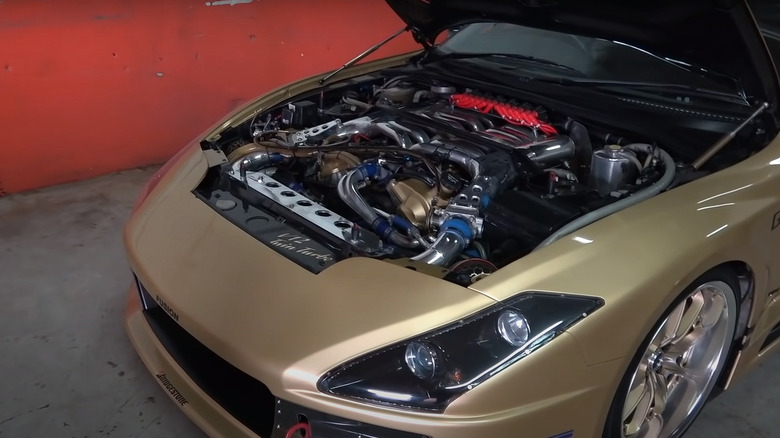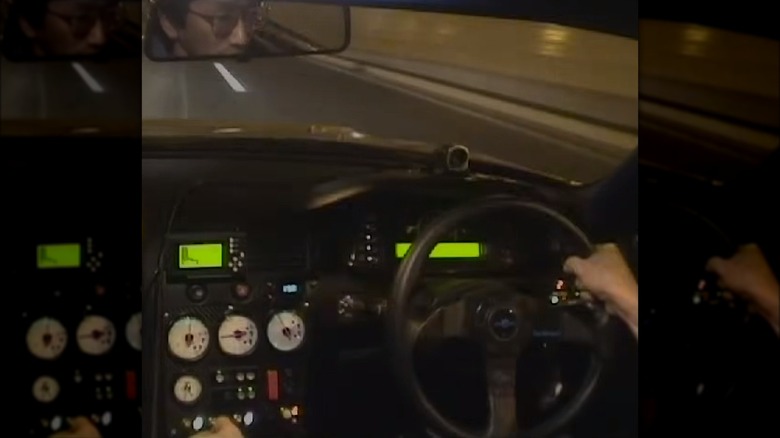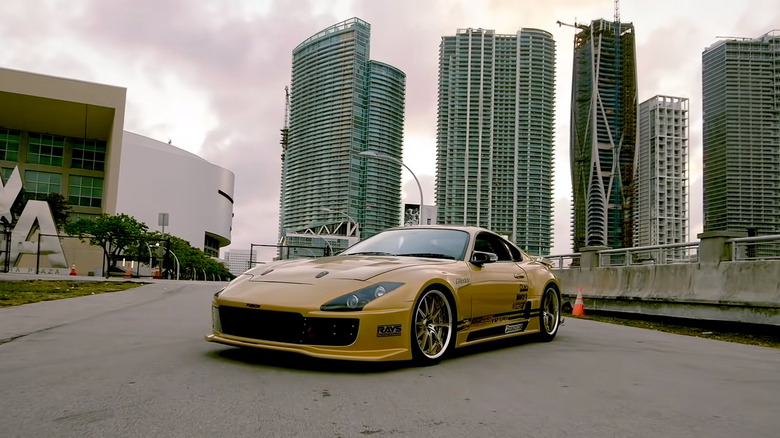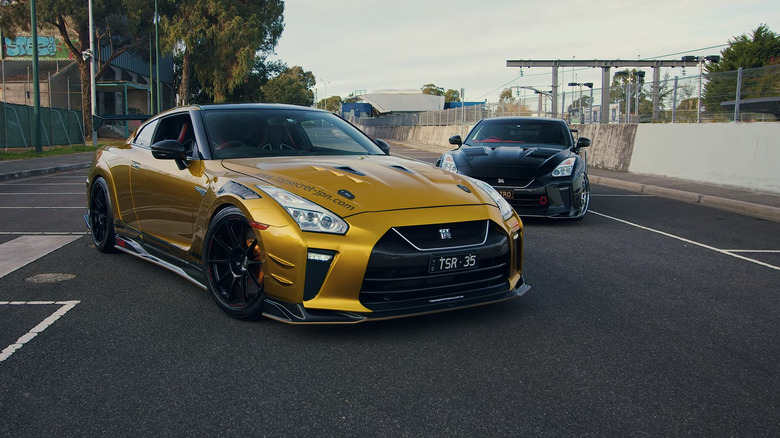Everything JDM Fans Should Know About The Smokey Nagata Toyota Supra
In the Land of the Rising Sun, the streets are filled with iconic and unique car creations. From cartoonish tuned kei cars to outrageous JDM supercars, Japan's enthusiast scene has something for everyone. Think about a wild car, and there is probably one in Japan. So vibrant is the Japanese tuning scene that it literally conquered the world — and the Toyota Supra and its renowned 2JZ engine are at the front of the pack.
However, the most unique and probably best Supra ever doesn't have a 2JZ under the bonnet! Enter the Smokey Nagata Toyota Supra –- a car so wild that even the most creative enthusiasts couldn't imagine. It was born from a man's stubborn ambition to break speed records and his pure love for cars and engineering.
Kazuhiko "Smokey" Nagata, the notorious tuning champion and owner of the Top Secret tuning company, is not your typical engineer. Born and raised on the street racing scene but still very well-versed in automotive engineering, Smokey has the ability to infuse unique art in each of his creations. Most of all, he dares to do the seemingly impossible, like a V12 or RB26DETT-powered Supra, and make them work.
Fasten your seatbelts because this story will put you on a golden Supra rollercoaster, where you will read about speeding tickets, the Japanese Rolls-Royce, and pure engineering ingenuity. Here is everything you need to know about the Smokey Nagata Toyota Supra!
There are actually three Smokey Nagata Supras
Contrary to popular opinion, the "Smokey Nagata Toyota Supra" isn't just one car. There are three, each with a unique engine and exterior design. However, every Smokey Nagata Supra was developed with the same quest: more speed! Still, the Supras are just a tiny part of the portfolio of Nagata's company, Top Secret.
The famous tuning brand also worked on countless Nissan GT-Rs. For instance, Top Secret created an R33 GT-R that reached 300 km/h in just 17 seconds. He also made a Nissan Skyline with a 4.5-liter twin-turbo V8 from the Nissan Cima. With that car, Nagata reached 341 km/h (211.9 mph) on an Autobahn in Germany, saying it could have gone even faster!
Other cars Top Secret worked on are the Toyota Aristo, Toyota Celica, Nissan 350Z, Nissan Silvia, and Acura Integra Type R. The studio still hasn't worked on a non-Japanese car, and each of its models only has Japanese engines -– no V8 LS swaps here!
The first Smokey Nagata Supra had a four-cylinder turbo
The Supra and its 2JZ engine set the bar for performance in 1994 when Toyota introduced its most advanced sports car. Meanwhile, the tuning scene started learning about the tough 2JZ-GTE engine and its extraordinary potential just a few years later.
However, instead of meddling with the now mythical powerplant, Nagata went on a different path –- a four-cylinder engine. Some might consider it heresy, but that was not your ordinary inline-4. It was the same unit that powered the Celica GT-Four, Toyota's rally-inspired street racer. Codenamed 3S-GTE, the 2.0-liter turbocharged unit produced 255 hp in its original form.
To satisfy Smokey's appetite for speed, the engine required quite a lot of modification. Nagata stroked it to 2.2 liters, installed beefier internal parts, and replaced the stock turbocharger with a much larger Trust/GReddy T88-34D one. The first Smokey Nagata also featured suspension, body, and brake system upgrades from brands such as RAYS, Alcorn, and Öhlins. The six-speed Getrag transmission was almost stock, though it was geared differently.
The result was a 700-hp widebody all-Japanese monster that reached more than 186 mph while having two more gears to work with. Quite impressive considering the number of cylinders; however, this Top Secret Supra was only the beginning.
The second version used the celebrated engine from Nissan's Skyline GT-R
Smokey Nagata again dissed the 2JZ for his second Toyota Supra and instead went with its biggest rival, Nissan's RB26DETT. Yup, the same one that sits in the R34 Skyline GT-R! The reason? Reportedly, he thought that the high-end power of the RB26 was more beneficial than the torque from the 2JZ for achieving high velocities.
Meanwhile, Supra's body was more aerodynamically efficient than Skyline's, so that combination would have worked best in his eyes. It might have also been a desire to create something unique – not unusual for Nagata. Either way, the second Top Secret "Nissan" Supra, first seen in 1999, had more than enough power to go way past legal speeds.
Though little is known about the particular parts Nagata used to reach that figure, the upgraded RB26DETT must have had forged pistons and rods, a larger turbo, improved cooling, and custom ECU mapping. The images and videos of the second Smokey Nagata Supra also reveal a more streamlined body and lowered suspension, both beneficial in high-speed runs. As a result, the improved machine could reach well beyond 200 mph (320 km/h). Nagata didn't officially test the car's top speed, though he earned a devoted fanbase by doing the speed tests on public streets.
The V12 version reached 930 hp
While his first two Supra inventions were already making a stir in the tuning scene, Nagata was busy working on an even faster and more peculiar Supra. This time, it packed Toyota's and Japan's only V12 engine, though tuned to the extreme with a twin-turbo setup.
The result was a speed monster that reached a top speed of 222.4 mph on Nardo's circular test track in Italy. The 5.0-liter V12 Supra might not have been too much faster than the previous RB26DETT-powered model, but it carried much more cachet. A Japanese V12 engine has never been seen in a tuned Japanese car up to that point, and you can't beat the sound of a V12. Crucially, the engine inside the V12 Smokey Nagata Supra produced 930 hp and 745 lb-ft (1,010 Nm) of torque, stunning figures for a car launched in 2007.
Still, Nagata and his colleagues at Top Secret had a lot of work to reach that figure, as the original engine was designed with smoothness in mind. Thus, apart from running two HKS GT2540 turbines at 17 psi boost, Top Secret also designed a custom intake with 80 mm throttle bodies for each bank and a more advanced cooling system to keep the temperature in check. Dual HKS F-CON V Pro ECUs ensured everything ran like clockwork, and the customary nitrous oxide ensured the engine was at its full potential.
It borrowed the V12 from the Toyota Century
The Japanese automotive culture is best known for its smaller yet powerful engines. Still, that's not to say these talented automakers didn't flirt with higher displacements and more cylinders. In the case of the third Smokey Nagata Supra, the 1GZ-FE 5.0-liter V12 engine comes from the JDM Toyota Century -– a hyper-luxurious limo made for the super-rich and politicians. Think of it as the Japanese Rolls-Royce, and you won't be far off.
The thing is that Toyota didn't design that engine with power in mind. Sure, the 48-valve unit produces 276 hp and 354 pound-feet (481 Nm) of torque, but that is nothing compared to some of its German rivals. With this motor, Toyota wanted to make the most refined and quietest powerplant possible and one that would have the smoothest power delivery. To achieve that, the engineers utilized Toyota's VVT-i (Variable Valve Timing-intelligent) and slant-squish combustion chambers.
However, just like its smaller brother, the 2JZ-GTE, Toyota's V12 is also designed to stand the test of time. It is so well-engineered that even if the ECU for one bank of cylinders fails, the engine can continue to run on only six cylinders. As such, it is a great platform for tuning, and as Nagata showed us in his third Supra, it could go north of 1,000 hp. Did we mention it also sounds fantastic when coupled with aftermarket intake and exhaust systems?
It's one of the few V12 powered Japanese sports cars
The third Smokey Nagata Toyota Supra is still one of the rare examples of all-Japanese tuned cars with Japanese V12 engines. There is a Toyota GT86 with a quad-turbo V12 version of Toyota's 1GZ-FE engine, probably inspired by Smokey Nagata's Supra. Meanwhile, New Zealand's Hartley Engines and Motorsport race a Nissan S14 drift car with the same V12, pleasing the crowd with its unique sound.
There are only a few other examples of V12-powered Japanese cars. That's because, for starters, those cars weren't designed with large engines in mind, and placing them under the bonnet is always a challenge. Then there is the fact that Toyota's V12 engine is quite rare simply because not many Century limousines are sold yearly. Not to mention, working on that engine is quite tricky, and there is not much aftermarket support.
However, this only adds to the appeal of Smokey Nagata's V12 Supra. When Top Secret first showed it to the world in 2007, it wowed the crowd and will continue to do so whenever it makes a public appearance. It is a sort of unicorn in the automotive world, and that probably won't change anytime soon!
Its cooling radiators sit in the trunk
Century's V12 fits Supra's engine compartment like a glove, allowing for two turbochargers and an elaborate intake setup. However, while there is enough room for a standard cooling system in the front of the engine, the tuned V12 monster needs more radiators to dissipate all that heat.
So, Nagata and his Top Secret team put the cooling radiators in the trunk. The cooling setup also uses four electronic water pumps and a complex plumbing setup to bring the cooling fluid to the engine and back to the radiators.
Furthermore, the engineers made opening ducts under the rear spoiler to guide air to the radiators for cooling purposes. This also aids in aerodynamics because, other than going through the radiators, the airflow is smooth and undisturbed. However, the ARC intercooler still sits in front of the engine, where the cooling is most efficient.
The body kit was designed for aerodynamic efficiency
Smokey is an engineer by heart and knows that cramming more power into a car won't necessarily make it faster. Bugatti, for instance, reached 253 mph with 1,001 hp, all thanks to its slippery body and a hydraulic suspension that lowers the car at higher speeds for an even greater aero advantage. The Smokey Nagata V12 Supra certainly had the power to (almost) match the Bugatti Veyron. However, Toyota didn't design Supra's body with such high velocities in mind –- the original 2JZ-powered MKIV model had only 320 hp on tap.
Thus, Nagata put a lot of emphasis on rebuilding the body. The Top Secret Super G-Force Wangan widebody kit looks much sleeker than other tuned Supras, with a lower rear wing (at first, the car had a higher GT wing) and a completely redesigned nose to aid aerodynamics. The V12 Supra also features Top Secret coilovers with Roberuta Cup kit, bringing it closer to the ground. However, Nagata also ensured the Supra was stable at its highest speeds -– the body also had enough downforce to keep it glued to the road.
Of course, Top Secret didn't have Bugatti's resources (like an aero tunnel), and Nagata could only design the body using software and sheer experience. As a result, the V12 Supra can't quite reach the same velocities as a Veyron, though at 229 mph, it is certainly no slouch.
Getrag six-speed manual transmission from the VVT-i Supra
Sculpting the body to achieve higher speeds is challenging, but Nagata also needed to overcome other obstacles, like making a manual transmission work with a V12 engine. Fortunately, the original 6-speed transmission from the improved JDM VVT-i Supra is famous for being sturdy, reliable, and able to bear a lot of torque as well as power.
Still, Nagata needed to design a custom housing for it to fit the engine, and he also reworked some of the internals to make it even beefier. Moreover, the V12 Supra has a Cusco 1.5-way LSD to put its immense power to the ground more efficiently and an ORC clutch that could sustain the engine's torque. Inside, a custom Top Secret shift knob and steering wheel gave the driver more control, which was crucial when driving at over 200 mph.
Shifting a six-speed manual in a 930-hp car certainly requires a skillful driver, so Top Secret made sure that power is efficiently delivered to the ground with Bridgestone's super-sticky Potenza RE050A tires, 245/35R19 front and 275/40R19 rear. Meanwhile, the gold Volk Racing GT-F 19-inch wheels shed some unsprung weight of the whole car while giving it a unique appearance.
It was developed for breaking speed records
By now, you were probably wondering -– how did Smokey get his nickname? Well, Kazuhaki Nagata is quite a childish fellow, one who won't miss doing a burnout whenever he sits behind the steering wheel. In that sense, he is almost like an anti-hero from a manga comic: a silent, non-assuming guy during the day but a driving maniac during the night. His shenanigans might not bode well with law-abiding citizens, but his character definitely attracts a particular octane-loving audience.
As much as Kazuhaki is known for smoking tires, he is even better known for his quest for speed. Every car the tuning lord develops is built to go faster, and Nagata almost always aims to reach 400 km/h (249 mph). He won't be the first to reach that speed globally, but he will undoubtedly be a pioneer in his own country. Building an all-Japanese sports car that reaches those velocities still motivates Smokey Nagata to this day.
Nagata tested the top speed on a public highway
The Top Secret Toyota Supra isn't famous just because of its V12 engine. It is Nagata's street antics that made him and his company so notorious in enthusiast circles. Namely, for the first 200+ mph run, Smokey took his second RB26DETT Supra to the U.K. and decided to utilize the A1(M) public highway to reach that speed.
It was early morning when Smokey Nagata parked his Supra on the almost empty highway and started doing his customary tire shredding. After heating the tires sufficiently, he went for it. There was an issue, though –- it had rained. However, Nagata was determined, and according to his measurements, he reached 194 mph before slowing down.
Nagata also brought a team and recorded the run with the idea of using it as a PR stunt. Boy, did it work -– Nagata and his Top Secret tuning studio quickly gained a cult following among auto enthusiasts. The fact that law enforcement caught him doing 120 mph just spiced up things. As a result, he was banned from the U.K. for 10 years, received a £155 fine plus £35 court fees, and got a one-month suspension on his international driver's license.
Although Nagata admits the run was morally wrong, he continued to use public roads to test the top speed of his creations. Notably, he frequently used Tokyo Bay's Aqua-Line tunnel to bring many of his cars beyond 200 mph.
Smokey Nagata doesn't own his Supras anymore
Although the Supras are Nagata's most famous creations, he had to part ways with all three. The four-cylinder powered Supra was imported to Norway in 2005, though it returned to Japan later. Interestingly, Japan Auto, who were caretakers of the Supra at the time, had a fire at their warehouse. Luckily, the Top Secret Supra only finished with a burnt roof. The car then returned to Norway, only to be sold later to an unknown customer.
Meanwhile, RMC Miami, a company that sells collector and vintage sports cars, bought the RB26 Supra from a large Supra dealer in Japan. The company says the car has done more than 100,000 miles of street racing -– impressive considering the upgrades and sheer power. To keep the car on the road, the RB26 engine was sent back to Top Secret in 2020 for an engine rebuild, a new clutch, and new turbochargers.
The most famous V12 Supra is also in Florida, owned by the Trap Team workshop. The firm acquired the masterpiece for less than $90,000 at an auction in 2018 –- mind-blowing when you consider that average Supras currently fetch similar prices. Trap Team might have struck gold (pun intended), but on the other hand, the price stalled Nagata's work on another Supra. Let's just hope that he uses his wild imagination with the BMW-derived Toyota Supra MK5!
Nagata's 250 mph quest continues with Top Secret's Nissan GT-R
We might never see another Top Secret Supra MK4, but that doesn't mean Smokey Nagata retired. Speed is this man's main driving force, after all, and one of his latest creations is a 1,100 hp R35 Nissan GT-R. With this car, Nagata hopes to finally break the elusive 400 km/h (250 mph) barrier and enter the exclusive company of Bugatti, Koenigsegg, and Hennessey.
Nagata already reached 377.2 km/h (234.4 mph) with the Top Secret GT-R in 2013, where he won the Nardo High-Speed Challenge. That top speed brings Smokey ever closer to his dream, but those extra 15 mph needed to reach 250 mph are more challenging to achieve than you would think. Due to the immense drag at those velocities, the additional power requirements to go just one mph faster become exponentially bigger.
Still, Nagata has used aerodynamic tricks to extract extra mph, including an F1-like DRS system that adjusts the spoiler's blade angle to make the car more slippery in a straight line and more stable in the corners. As customary for a Top Secret speed machine, the GT-R has the same gold color as the three Supras.
